New:
The FOA
2018-19 Update Page covers all the new technology and
applications we covered in this newsletter in 2018-19. Now you
can review all that new tech at once.
The FOA
Fiber FAQs Page (FAQ s = frequently asked questions)
gathers up questions readers have asked us (which first ran
in this newsletter) and adds tech topics of general
interest.
This
months "Good Questions" has some unique
questions from our readers.
Is That
A Good Idea?
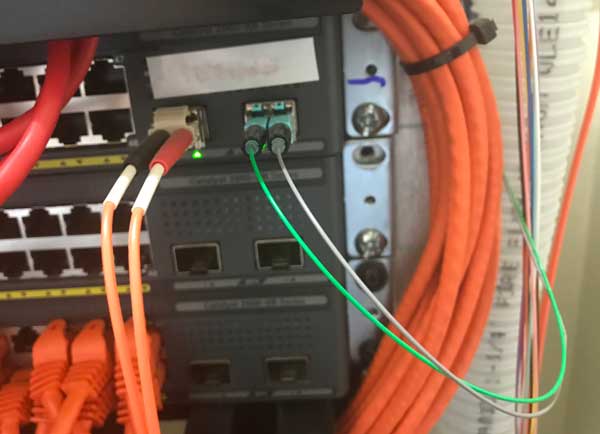
FOA
received an inquiry this month from a contractor who had a
customer questioning using patch panels to terminate cables and
then connecting hardware with a patchcord. Why not just
terminate fibers directly and plug them into equipment, saving
the cost of patch panels. FOA argued for protecting the fibers
and using patchcords which also simplifies moves, adds and
changes.
This is an example of someone doing that. Two fibers were
terminated on the fibers directly and the fibers looped around
the side of a rack to plug into equipment. We were on a tour
with a number of others and we were crowded around this rack.
Doesn't it seem bad judgement to leave fibers like this, not
like the two connectors next to them which are in 3mm jacketed
cables with strain relief boots on the connectors? One of us
could have easily hit these two fibers and broken them. Then,
they would have to be reterminated. If that happened to the two
fibers beside them, the patchcord could have been replaced and
the link would be back in business.
We recommend using patch panels. Here are some examples of
simple modules for use in terminating cables for patching. These
are Multilink
CT-X modules for termination only and splicing. They
protect the cables and fibers and simplify patching.

Fiber
Optic Manufacturing in Space
FOA
recently interviewed Dr. Dmitry Starodubov, Chief Scientist, FOMS,
a small company in San Diego that has been making fibers in
space on the International Space Station (ISS). FOMS has
developed a instrument for fiber fabrication in space
environment that can make up to hundreds of km of fiber per
mission.
 ISS
National Lab Photo
ISS
National Lab Photo
Dr. Starodubov was recently honored for this achievement at the
ISS R&D Conference. (2019
ISSRDC Award: Demonstration of Patented Hardware for In-Space
Manufacture of ZBLAN Fibers- be sure to watch the video)
The project has shown that a microgravity environment improves
the quality of specialty optical fibers with the promise of up
to 100x reduction in insertion loss. One type of fiber, ZBLAN,
has the potential of losses in the range of 13-22 dB per 1000km
at 2500nm, higher in the IR that conventional fibers used today.
Fiber optic manufacturing on a low earth orbit platform could be
a surprisingly affordable manufacturing approach due to low mass
and high value of optical fiber products.

Dr.
Starodubov and NASA Lead for Integrative Studies Lynn Harper
inspect the results of Space Fiber program by FOMS.
For more information, contact FOMS, 3525 Del Mar Heights Road,
#236 • San Diego, California 92130 • 1.858.342.0993 • www.fomsinc.com
Does
Your Telecom Room Look Like This?

Yes, this hotel in Las Vegas has the LAN and video cabling for
the floor of this hotel on the wall in a housekeepers closet.
10GPON
Update In FOA Guide
FOA has
updated its page on FTTH PON protocols to include the latest
standards for 10GPONs. There are three standards, NG-PON2,
XG-PON and XGS-PON. As is common with all communications
networks, work on upgradeing network capability and speed starts
as soon as a network is introduced and PONs are no exception.
GPON has been the most widely used PON scheme for both FTTx
netowrks and passive optical LANs (OLANs) and GPON has been
upgraded to several versions with higher transmission speeds and
higher power budgets to allow greater distance, higher split
capability, or both. The assumption is that a fiber network has
a lifetime of up to 40 years, so upgrades to GPON have assumed
that they will use the same passive optical network architecture
and fiber type (G.652 singlemode.)
Furthermore, upgrades have been designed around coexistence with
current GPON networks. By utilizing different wavelengths, it is
possible to have these newer, faster networks sharing the same
passive optical network as the original GPON system, allowing
offering higher speeds to users while continuing to serve
current users without disruption. Some commercial users can take
advantage of higher speeds while typical consumers are well
served by GPON. One of the big advantages of the PON upgrade
standards is the ability to overlay networks. Thus a city could
operate one regular GPON network for consumer FTTH use and have
another, faster network operating on the same cable plant
independently, offering a higher level of service and security.
More on
PON Protocols in the FOA Guide.
Testing
Multimode Fiber With BI Fibers
FOA sent a
contribution to the last TIA standards meeting looking for
clarification on the use of bend-insensitive (BI) fibers for
testing, as well as what fibers to use when testing BI MM
fibers. It seems to be a bit odd to be discussing this topic
since BI fibers were introduced a decade ago, but this issue
remains unresolved.
The problem is as follows:
1. Most standards say do not use BI MMF for reference test
cables. This is because standards call for launch cable mode
conditioning (mandrel wrap or encircled flux) that is
ill-defined for BI MMF. Except one standard. FOTP-171B has one
section saying no BI MMF (Sec. 3.6.1) but another (A.3.2) says
to use the same type of fiber for reference cables as in the
cables you are testing.
2. Manufacturers are mostly making BI MMF today. OFS is the one
manufacturer that says they continue to make non-BI MMF.
3. As far as anyone knows, nobody marks on the jacket of cables
whether the fiber is BI or non-BI. There seems to be consensus
that is should be marked, but no standard exists to require it.
4. Many test equipment vendors provide non-BI MMF for test
cords. Nobody else was identified as a supplier.
Conclusion? We're about where we were a decade ago.
Over
critics’ objections, L.A. Metro approves $4.4 million for
South Bay internet project
Los Angeles
County transportation officials on Thursday unanimously approved
$4.4 million in funding for a high-speed internet system in the
South Bay. A coalition of 16 cities, including Carson and
Torrance, had pitched the fiber-optic cable ring as a way to
alleviate congestion by allowing government employees to
telecommute and by helping to synchronize traffic lights. The
funding will be covered by Measure M, the sales tax increase for
transportation projects.
Some business groups disagreed. “While a fiber optic network may
be a worthy project, it is not a transportation project,” said
Maria Salinas, the president and chief executive of the Los
Angeles Area Chamber of Commerce. Funding the fiber project
through Measure M is a “highly questionable decision,” she said.
Read
more from the LA Times.
Not
Much Future For Cat 8 and Wideband MMF (OM5)
TIA's
FOTC - Fiber Optic Technology Consortium - shared data at their
fall meeting recently that is highly instructive. Based on
feedback from viewers of several of their webinars, when asked
if they planned to use two components, the results were:
Cat
8 - 1%
Wideband MMF (OM5) - 1% (with a further 16% maybe in the
future)
It does not seem like those components have a real future.
Need
More Ethernet?
Here is a
standards committee that stays busy! Bob Metcalfe, the
co-inventor of Ethernet once said "The wonderful thing about
standards is we have so many to choose from."
IEEE 802.3ca: 25 and 50 Gb/s PON Ethernet
IEEE 802.3cm: 400 Gb/s over MMF
IEEE 802.3cn: 50/200/400 Gb/s > 10 km SMF
IEEE 802.3cp: Bidi 10/25/50 Gb/s over single SMF ≥ 10 km
IEEE 802.3cp: Bidirectional 10/25/50 Gb/s over single SMF ≥
10/20/40 km
IEEE 802.3cs: Increased-reach Ethernet optical subscriber access
(SuperPON) (SMF)
IEEE 802.3 Multi-Gb Automotive Optical PHY Study Group
IEEE 802.3cg 10 Mb/s Single Pair Ethernet (copper)
IEEE 802.3ch: Multi-Gb Automotive Ethernet PHY (copper)
Can
You Learn Skills Online?
That's
a tough one. Learning skills requires "hands-on" practice and
that requires tools and components to practice with. But FOA has
a course on Fiber
U called "Basic
Fiber Optic Skills Lab" that introduces you to the tools
and equipment then takes you through cable prep, splicing,
termination and testing. If you have completed the Basic
Fiber course and already have a set of fiber
tools, this course will help you to learn how to
use the tools and learn basic fiber installation practices
which you can practice using your own equipment.

What About Safety?
That's the subject of a future FOA Newsletter
Worth
Reading - News Summary
September
2019
"Show
Great Georgia Jobs" TV Features Southern Fiberworx

Southern Fiberworx was one of the first "Do-It-Yourself" FTTH
networks which FOA worked with to help get started. Greg
Turton's company has been amazingly suffessful and is recognized
here for it's accomplishments. This
is a video worth watching!
Introduction
To Singlemode Fiber
Well-written white paper by Leviton. When you see how many
generations of MMF have been introduced while we use the same
old SMF, you'll get the idea. And their analysis of SM
transceiver cost is revealing.
How
OFS Makes Fiber
Interesting YouTube video on how fiber is made. Perhaps a little
too much "show biz" but fascinating. If you have ever seen fiber
manufacture, look at this video. You will be amazed at how big
preforms have become!
5G
Rollout To Create 3 Million New Jobs, Adding $500 Billion To
The US Economy
5G, the next generation of wireless technology will create 3
million US jobs adding $500 billion to the US GDP according to a
recent report by Accenture. (Remember our articles on "Fighting
Misinformation" - bullshit - recently?)
WHY
WIFI IS FAILING YOUR BUSINESS (Is that so or is this
competitive obfuscation?)
"WiFi trouble in the workplace is inevitable, and it is costing
your business time and money. WiFi simply cannot support your
business-critical operations because it was not engineered to
meet your growing data demands. Citizens Broadband Radio Service
(CBRS) is latest spectrum released by the FCC that is ready to
put all your WiFi failures behind you." This webinar seems to be
more for our "Fighting
Misinformation" segments. CBRS is new frequencies
that will be shared between military users and cellular
service providers. Does that sound reliable? And 5G uses the
same protocols as the next WiFi version - WiFi6 - so why is it
going to have more throughput. Are they just trying to sell
you a DAS?
Driverless
Vehicles Must Have Own Highways, Says Hella
Autonomous cars must be kept away from ‘normal’ traffic, a
leading auto supplier has insisted.
China's
Data Centers Alone Will Soon Use More Electricity Than All
Of Australia
Between 3% to 5% of all electricity used globally comes from
data centers that house massive computer systems (WBUR, Boston,
MA, USA)
Pa.
Turnpike installing fiber optic system, to lease extra
capacity
The turnpike is moving on its own to install a fiber-optic
communication system in the eastern part of the state to meet
its internal needs and is designing it with extra space that it
will solicit private operators to lease.
KentuckyWired
broadband project completed in Eastern Kentucky,
and
there's more
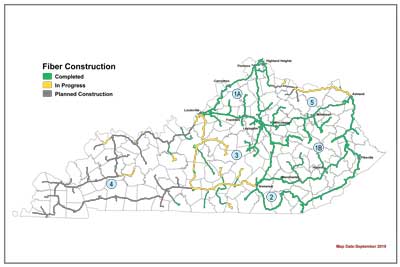 KYWired KYWired
FOA schools are training workers for this project since it
began. FOA hosted a Workforce
Summit in 2016 to kick off the program. Here
is the project website.
Belden’s
Digital Electricity Cables reach distances and wattages that
PoE can’t
Designed in conjunction with VoltServer, Belden’s Digital
Electricity Cables are available in copper-only and hybrid
copper/fiber constructions. PoE stretches the limits of 4-pair
unshielded twisted pair copper (Cat 5) because the conductors
are very small, so Bleden makes cables with bigger conductors
capable of handling higher currents safely..
In Case
You Missed These From Past Issues:
What
Makes a Red Sky at Night (and at Morning)? You might
wonder why this is in a newsletter about fiber optics, but it's
quite relevant. The mechanisms that make the sky blue during the
day and redder at dawn and dusk can teach you about the
mechanisms of loss in an optical fiber.
Tellabs
Optical LAN At Texas A&M Athletic Field - 27TB
downloaded, 1.5TB uploaded during game!
New
York Stock Exchange Uses MIcrowaves Because They Are Faster
Than Fiber. Of course, radio waves travel near 1C while
light travels through glass at ~2/3C.
Massachusetts
helps towns building own fiber networks In
all, the state office has so far marshaled $3.5 million from a
contingency fund to cover unforeseen costs for seven towns.
State
Legislative Initiatives to Restrict Low-Voltage
Contractors and Integrators From Installing Equipment,
Cabling and Infrastructure.
The
True Cost of Telco Damages (what backhoe fade or
target practice can cost)
Rural
Electric Cooperatives: Pole Attachment Policies and Issues,
June 2019.
Ckearfield-FOA
Certification Training Clearfield is now
offering their customers an FOA
CERTIFICATION course. This course provides a
basic understanding of fiber optic technology, as well as
Clearfield product knowledge and how Clearfield’s integrated
product systems work together in a fiber network.
Making
the most of your FTTX investment (10G PON by ADTRAN).
5
Best Practices for Utilizing GIS Data.
(White paper) American City & County
Substandard
Contractors - Fiber Optic Knowledge Doesn't Always Trickle
Down (EC Mag)
Preparing
For WiFi 6. (Siemon white paper on cabling for
IEEE 802.11ax))
Another
Source Of Articles On Fiber
FOA
President and editor of this newsletter Jim Hayes has also been
writing a column in Electrical
Contractor Magazine for almost 20 years now. Electrical
contractors do lots of fiber work and this column has covered
some topics they are interested in including installation
processes, network design, fiber applications and a lengthy
series on dark fiber - what it is, how's its used and how it
benefits the growth of communication. A recent web site redesign
makes it easier to browse all these articles - just go to http://www.ecmag.com/contributing-authors/jim-hayes
and you can see all of them.
Introducing
Lennie Lightwave's Guide - 25th Anniversary Edition
FOA has
reprinted "Lennie
Lightwave's Guide" on its 25th anniversary in a special
print edition.

Many of you have used the current online version of Lennie's
Guide on the FOA website. Now you can have a slick printed
version - real paper - you can hold in your hand and read. Leave
a copy on your desktop to impress your friends, or on the table
in your company's reception area instead of out-of-date
magazines. Give them to your customers and employees to help
them learn fiber optics. Use it to prepare for FOA
certifications. FOA will be giving them away at conferences like
the IMSA Annual Conference in New Orleans later this summer.
You can get your own copies of Lennie
Lightwave's Guide at Amazon.com, only $9.95US.
Another
Look At Connector Contamination
Brian
Teague of Senko
Advanced Components sent us the results of an interesting
experiment he ran to show an unusual effect of the contamination
on a connector. He started with a clean SC/UPC singlemode
jumper, shown in the 400X image to the left. Then he connected
it to a 1310nm laser test source and measured the power out of
the fiber with a fiber optic power meter. Then he disconnected
the connector from the meter, touched the end to his finger,
contaminating the end of the ferrule as you can see in the image
on the right.
But then he connected the dirty connector to the meter and
measured the power again. The power was decreased by 0.22dB.
Yes, the contamination on the connector acted as an attenuator
to reduce the power considerably. Think what would happen if you
them mated it to another connector. Not only would you see the
attenuation caused by the contamination, you will probably see
even more loss caused by the gap created by the flakes of skin.
That's why you should inspect, clean and inspect again to ensure
all connectors are clean before testing or making connections.


The 28th
International Plastic Optical Fibers (POF 2019) will be held at
Keio University Hiyoshi Campus, Yokohama, Japan from November
20th to 22nd. Objective & scope of the conference is to
discuss the latest developments of POF and a variety of POF
related applications. During
the conference, there will be Special Session featuring
lectures by world’s leading experts and demonstrations over
the advantage of POF in occasion of 10th anniversary of Keio
University Photonics Research Institute (KPRI).
More
on POF2019 in Yokohama.

The CGA
811 Excavation Safety Conference & Expo is the
premiere international event in the damage prevention industry.
This event has featured education to help all stakeholder
groups, and opportunities to network with industry peers, learn
safe practices, and lower costs associated with underground
damages.
Put this conference on your calendar - the focus is safety in
construction. FOA will be talking about "New Construction
Techniques In Fiber Optics." Want to submit a paper yourself? Go
here.

Interested
in the infrastructure of smart cities as they deal with the
future of connected and automated vehicles? This comprehensive
educational conference combines presentations, panel discussions
and tutorials, along with visionary keynote speakers, to provide
an end-to-end understanding of the infrastructure requirements
and business opportunities in V2X systems. The meeting is run by
SmartGig Media who ran the excellent SmartGig Cities conferences
a couple of years ago. FOA plans to attend because this is one
big aspect of the evolution of metro communications and relates
to the interest of our new certification partner IMSA, the
traffic engineers.
Learn more
High
Fiber Count Cables - Continued Updates
Nothing new this month...
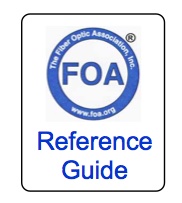
We are
continually updating the Online Reference Guide to keep up with
changes in the industry and adding lots of new pages of
technical information. When you go to the FOA
Guide Table of Contents to see the latest updates - look
for  . .
PON
Protocols in the FOA Guide. 10GPON
Update In FOA Guide
Basic
Fiber Optic Jargon, OSP
Fiber
Optic Jargon and Fiber
Optic Jargon for managers.
FOA
has a new page on Restoration
The
updated Fiber
Characterization page in the FOA Guide goes in to more
depth on why fiber characterization is important, what tests
need performing and how to interpret results.
Practically every page in the section of the FOA Guide on Fiber
Optic Testing has been reviewed and updated, much of it based on
the new FOA textbook on testing. This includes pages on
measuring power, fiber attenuation, connector or splice loss and
cable plant loss. Browse
through the testing section and see what's new.
We've
started with a page in the FOA Guide on Fiber
Optic Network Management that describes what our advisors
think is important and created a page to introduce them to the
language and technology of fiber optics which we call "Fiber
Optic Jargon - Illustrated." Over time, we'll be expanding
this section and create a Fiber U self-study course also.
FOA has
created a new section of the FOA
Guide on OSP
Construction.
Inspecting
and Cleaning Connectors.
Dirty
connectors are one of the major problems in fiber optics,
causing high connector loss, high reflectance and contaminating
transceivers. Network operators claim that 15-50% of all network
problems can be traced to dirty connectors causing connection
problems.
FOA
Guide section on inspecting and cleaning connectors.
Go
to The
FOA Online Fiber Optic Reference Guide.
FOA
School Offers Toolkit With Online Training

Slayton
Solutions (FOA Approved School #156) is offering a simple
fiber optic tool kit that includes a 29-piece set of fiber
optic tools and a power meter along with training videos and
online instruction for only $499. 29 Piece Kit includes all
tools and devices a technician needs to install fiber optic
connectors and test optical power. Information
on the kit is available on YouTube.
You can contact them for more information at
slaytonsolutions@sbcglobal.net
or https://www.fiberopticsinstitute.com
New
FiberNext Job Board And Savings Club For CFOTs

FOA
Approved School FiberNext
has created an online job board for fiber techs and a special
"savings club" for CFOTs.
Job
Board
The
Job Board was designed to help connect employers with fiber
technicians and other fiber optic professionals. It is a place
where employers in the fiber optic market can post job
openings and a place where fiber optic professionals can post
that they are looking for employment. Please feel free to post
an opening or browse for your next job or employee. https://fibernext.com/job_board.php
Savings Club
FiberNext, besides being an FOA approved school is also a
distributor. FiberNext invites FOA CFOT®s to join the “FiberNext
CFOT® Club to get special savings on selected fiber optic
products. Visit https://fibernext.com/cfot_club.php to
sign up today ”
Recycling
Fiber Optic Cable
We
received this note from Steve Maginnis, LD4Recycle/ CommuniCom
Recycling on recycling fiber optic cable:
We have 3 Processors gearing up to accept fiber optic
cable (FOC). As we all know, all FOC is not the same. Several
truckloads of “typical” FOC scrap from FOC mfgrs and “typical”
FOC and Coax cable have been studied and tested.
Therefore, today you can begin contacting me with the type FOC
material or scrap you toss to the landfills today. We need to
quantify the expected feedstock. Our expectation for quantities
is quite large (tons) but there is a capacity limit. And I do
have several processors that can take ALL materials and others
that can accept LIMITED types of FOC material and quantity.
Contact:
Steve Maginnis
LD4Recycle/ CommuniCom Recycling
(Visit our new
website)
sm@LD4Recycle.com
803.371.5436
Safety
On The Job
Safety is
the most important part of any job. Installers need to
understand the safety issues to be safe. An excellent guide to
analyzing job hazards is from OSHA, the US Occupational Safety
and Health Administration. Here
is a link to their guide for job hazard analysis.
FOA also has lots of information on safety: FOA
Guide, YouTube
video and a Safety
Poster
Best
Practices Guide For Underground Construction

We assume
you are familiar with the "One Call" and "Call Before You Dig"
(811) program, but are you also familiar with the people behind
it - the Common Ground Alliance and their Best Practices
website?
CGA
is a member-driven association of 1,700 individuals,
organizations and sponsors in every facet of the underground
utility industry. Established in 2000, CGA is committed to
saving lives and preventing damage to underground
infrastructure by promoting effective damage prevention
practices. CGA has established itself as the leading
organization in an effort to reduce damages to underground
facilities in North America through shared responsibility
among all stakeholders.
Officially
formed in 2000, the CGA represents a continuation of the
damage prevention efforts embodied by the Common
Ground Study.
Sponsored by the U.S. Department of Transportation and
completed in 1999, this Study represents the collaborative
work of 160 industry professionals who identified best
practices relating to damage prevention. Any
best practice or program endorsed by the CGA comes with
consensus support from experts representing the following
stakeholder groups: Excavators, Locators, Road Builders,
Electric, Telecommunications, Oil, Gas Distribution, Gas
Transmission, Railroad, One Call, Public Works, Equipment
Manufacturing, State Regulators, Insurance, Emergency
Services and Engineering/Design.
Read
the CGA Best Practices Guide here.
Here
are all the CGA resources for damage prevention.

The word on
the "Dig Once" program is getting out - FOA is getting calls
from cities asking us for information and advice. It helps that
the current Administration is trying to convince cities of the
advantages of installing ducts or conduits when they dig up a
street so they don't have to do it again. Here are some links
for more information.
The DoT page on the administration’s Executive Order: http://www.fhwa.dot.gov/policy/otps/exeorder.cfm
From the Council of State governments: http://www.csg.org/pubs/capitolideas/enews/cs41_1.aspx
From the city of San Francisco: http://sfgov.org/dt/dig-once
An article about Dakota County, MN: https://muninetworks.org/tags/tags/dig-once
And
the one to download and hand out:
A “How To” Guide from The Global Connect Initiative: https://share.america.gov/wp-content/uploads/2016/04/6.-GCI-Dig-Once.pdf
Useful
Online Resources
We often
have contacts give us online links for useful information which
we like to share with our readers. Here are two:
Why
We Warn You To Be Careful About Fiber Shards
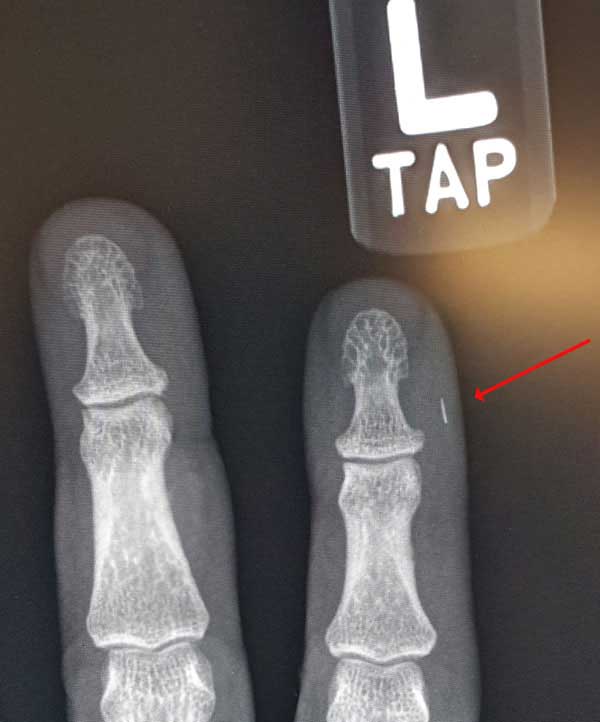
Photo courtesy Brian Brandstetter, Mississauga
Training Consultan
FOA
Facts
FOA is a
non-profit professional society chartered to promote
professionalism in fiber optics through education, certification
and standards. FOA is mostly known for certifying techs -
mostly CFOT®s
-Certified Fiber Optic Technicians - but also may be CPCTs -
Certified Premises Cabling Technicians or corporate
members involved in fiber optics.
FOA is a "virtual organization" - we have no "brick and mortar"
presence. We operate over the Internet with operations centered
in California, with active workers and volunteers in locations
as diverse as Texas, Ohio, Canada, Singapore, Malaysia, Denmark,
South Africa, the Middle East and many more.
Being a virtual organization, FOA has very low overhead,
allowing us to offer cost-effective certifications and many free
programs to support our industry.
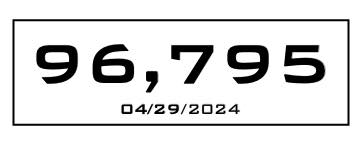
As of today, FOA has certified this many techs. About 90% come
from our schools but many experienced techs have become FOA
CFOT-certified directly through our "Work-to-Cert"
program.
FOA has almost 200 approved training organizations in about 40
countries around the world around the world.
FOA
Certifications Now Last For 3-Years
Beginning
in 2019, all FOA certifications issued or renewed will be for a
period of 3 years. Most certification bodies worldwide have
standardized on 3 year certifications. FOA has been working with
a number of organizations that use our programs but have
standardized on 3 year certifications. FOA has decided that it
is time to change our policies to align with the majority of
other organizations.
Remember that FOA certification renewals include all the
certifications one individual has for one price. FOA does not
charge for any additional certifications, so, for example, if a
CFOT also has specialist certifications like the CFOS/T or
CFOS/S, they are included at no additional cost when the basic
certification is renewed.

FOA has 14
fiber optic certification programs covering every aspect
of fiber optic network design, installation and operation.
Primary
Certifications: CFOT (basic fiber), CPCT (premises cabling),
CFOS/O (outside plant, taught with CFOT included) and CFOS/D
(fiber optic network design).
Skills Certifications (for installers and techs, requires
CFOT): CFOS/S (splicing), CFOS/C (connectors/termination),
CFOS/T (testing), CFOS/FC (fiber characterization).
Applications Certifications (for techs or anyone, including
managers and supervisors): FTTH (fiber to the home), CFOS/L
(optical LANs), CFOS/DC (data centers), CFOS/A (fiber to the
antenna), CFOS/DAS (distributed antenna systems) and CFOS/W
(fiber for wireless)
 (what you are reading)
(what you are reading)
FOA monitors the trade press, websites and other
resources continually to look at what's happening in many
technologies that affect fiber optics. We're tracing
technologies as diverse as wireless, IoT, autonomous vehicles,
smart cities, energy, or anywhere fiber is used to bring news to
our readers.
FOA continually updates our technical materials, online and
printed, and our curriculum to ensure our readers have access to
the latest technical information and our schools teach the
latest technology and applications. Our printed books are being
updated right now.

FOA created the
FOA Online Guide as a non-commercial trustworthy technical
reference almost a decade ago so the industry would have a
reliable technical reference. In the last year, over 1million
visitors downloaded about 4 million pages of technical
information.
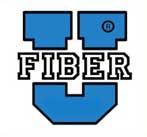
FOA offers free online self-study programs at Fiber
U. In 2017, the number of online sessions doubled to
200,000. Many of those are preparing for FOA certification
programs - taking courses at our schools or using the "Work-to-Cert"
program. Some of our schools are requiring Fiber U programs as
prerequisites for their classroom courses so they can spend more
time on hands-on activities.

FOA offers over 100 educational YouTube
videos that have been viewed 2.4 million times.
FOA offers its training programs to other organizations at no
cost to help them train their members properly in fiber optics.
For example, FOA has been working with the Electrical Training
Alliance (IBEW/NECA) for over 20 years, training their
instructors for their apprenticeship programs. We work with many
other organizations and companies to provide the materials they
need.
FOA has about 300 corporate
members - companies in various aspects of the fiber optic
industry worldwide that we list online and offer discounts on
certifications and renewals.
FOA provides speakers for many conferences and even
presentations for use by other organizations to educate people
on the aspects of fiber optic communications.
FOA has a program to provide classroom
materials for STEM
teachers (science, technology, engineering and math)
introducing K-12 students to fiber optics and creating science
projects.
FOA provides forums for discussion on various social media. Our
LinkedIn groups have about 5,000 members each. If you are not
joining us on social media yet, please do.





Interested
In A Career In Fiber Optics?

FOA has created a new YouTube video to introduce students to
careers in fiber optics. It was made for showing to high school
and junior high students interested in tech careers but anyone
interested in a possible career in this field will find it
interesting. If you have kids in school or know teachers, let
them know about this too. Watch the FOA
Careers In Fiber Optics Video on YouTube and visit the FOA
Careers In Fiber Optics web page at www.foa.org/careers/.
ts
1-844-440-0047
www.fiberoptictraining.com
Fiber
Optic Education For Students At Any Age
We hear
about fiber optics all the time - it's in the news whenever we
hear articles about high tech, the Internet and communications,
and many communities are getting "fiber to the home." But few
people really understand fiber optics or how it works. FOA is
focused on educating the workforce that installs and operates
these fiber optic networks but we're always getting inquiries
from STEM (science, technology, engineering and math) teachers
who want to introduce fiber optics to younger students in K-12
grades or technical schools.
We
start with the FOA
Careers In Fiber Optics Video on YouTube and visit the FOA
Careers In Fiber Optics web page at www.foa.org/careers/.
These are for students who think they might be interested in
careers in fiber optics and want to know more about what fiber
techs do.

Using red laser light (a VFL here but a laser pointer works
also) to show how fiber guides light.
FOA has begun developing a series of YouTube videos intended for
teaching students in elementary, middle and high schools about
fiber optics. The first FOA video is titled "Fiber
Optics For Teachers." With this video, we show teachers
how fiber works and carries signals and then explains simple
experiments to demonstrate how fiber optics works in the
classroom using some plastic fiber and a laser pointer. Since
many teachers do not know where to get the fiber, the FOA offers
to send them a sample for use in demonstrations in their
classroom (USA only right now.)
At the end of the video, teachers are given directions on how to
request samples of the plastic fiber from the FOA.
This video joins the "Fiber Optics Live" series How
Light Travels In A Fiber, Fiber
Attenuation and Connector
Loss that show how fiber works using simple experiments
that can be duplicated in any classroom. More videos will be
coming soon.
If you have kids or know some teachers who would be interested,
please send them to the introductory video Fiber
Optics For Teachers and we'll be glad to help them
get started with some entertaining programs for their
classrooms.
Resources
For Teachers In K-12 And Technical Schools
Teachers in all grades can introduce their students to fiber
optic technology with some simple demonstrations. FOA has
created a page for STEM or STEAM (science, technology,
engineering, arts
and math) teachers with materials appropriate to their
classes. Fiber Optic
Resources For Teachers.
If
you have kids in school or know teachers who are interested,
send them to the FOA page Fiber
Optic Resources For Teachers.
Should
Your Company Become An FOA Corporate Member?
As all FOA
individual
members know, they join the FOA by becoming certified,
mostly taking their CFOTs but some CPCTs, either by
attending a FOA approved school or joining directly based on
field experience (our "work to cert" program.) Over the years,
we've been contacted by manufacturers, contractors, consultants,
and other types of organizations who ask about becoming members.
We don't certify companies or organizations, we told them, so we
were not sure what we could offer as a benefit of membership.
But then, companies asked about using our educational programs
to train employees, how they could get listed on the FOA website
as service providers or if they could get a quantity discount on
membership or certification for all the FOA members working for
them. That began to sound like a benefit for being an FOA
corporate member. And providing a list of useful suppliers to
the market could be a benefit to the industry as a whole.
So FOA has quietly been letting companies and other
organizations join the FOA to take advantage of those benefits
so we now have several hundred corporate members. We've put then
into a database and listed them on the FOA website in map
and list
form. Here's the map.

The online map
and list
can be used to find suppliers and service providers.
The map, like our map of schools, lets you find the FOA
corporate members close to you. The table form lists them
by category: Installer/Contractor, Component Manufacturer,
Installation Equip. Manufacturer, Transmission Equipment,
Services/Consulting, Distribution and Users of Fiber Optic
Networks. You can sort the tables to find members meeting your
needs, e.g. by location, certifications offered, etc. Click on
any column heading to sort that column; click twice to sort in
reverse order.
How
Does An Organization Become An FOA Corporate Member?
Simple,
just fill in the online
application form. When your application is accepted, you
will be asked to pay the one time membership fee - $100US. You
will then be listed on the online
map
and list,
have access to exclusive FOA educational materials for your
employees and get discounts on certifications and
renewals.
Events of
Interest: FOA
now posts events on our LinkedIn groups, Facebook page and
other social media

FOA
has a company page and three LinkedIn Groups
FOA
- official company page on LinkedIn
FOA
- covers FOA, technology and jobs in the fiber optic marketplace
FOA
Fiber Optic Training - open to all, covers fiber optic
technology and training topics
Grupo
de La Asociación de Fibra Óptica FOA (Español)
RETURN
TO INDEX
 FOA Resources
FOA Resources
FOA
Standards:
FOA offers free standards for datalinks and testing the
installed fiber optic cable plant, patchcords and cable, optical
power from transmitters or at receivers and OTDR testing. Look
for the "1
PageStandard" web page and in the FOA Online Reference
Guide.
NECA/FOA
301 Fiber Optic Installation Standard

Standards
cover components and systems and how to test them, but rarely
get into installation issues. The FOA NECA 301 standard which
covers installation of optical fiber systems has been revised
for the second time, adding considerable new materials. This
standard is derived from FOA educational material put in
standards form and approved by ANSI as an American National
Standard. It's specifically written to be used in contracts to
define "installation in a neat and workmanlike manner." The
standard is available from NECA.
FOA members can go
here for instructions on how to download your free copy.
RETURN
TO INDEX

Free
Fiber U Self-Study Programs
FOA's
"Fiber U" free online self-study programs help you learn about
fiber optics, study for FOA certifications or use them to help
create "blended learning" classes. There are two new free online
self-study programs on Fiber
U. Fiber Optic Network Design is for those interested in
learning more about how to design fiber optic networks or
studying for the CFOS/D certification. FTTx is for those wanting
to know more about fiber to the "x" - curb, home, wireless, etc.
- or studying for the CFOS/H certification.
Got to Fiber U
for more information.
Fiber U
Online Self-Study Programs Offer Certificates of Completion
FOA has
been offering quite a few free online self-study programs on Fiber
U, our online learning site. We are always getting
questions about getting a certificate for completing the course
online, so we have setup an option to take a test online and get
a certificate of completion for these online courses.

While it's not FOA certification, FOA will recognize a Fiber
U Certificate of Completion as background experience to
qualify for applying for FOA certifications. We also intend to
expand the program to more specialized topics as preparation
for FOA specialist certifications.
If you have associates that want to get started in fiber,
have them take this course online to get started. Go to Fiber
U and get started.
FOA
Books And Publications
Updated
Books
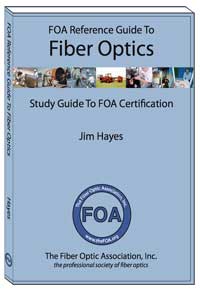

Many textbooks are behind the technology because they are
rarely updated. FOA really keeps our textbooks up to date. We
did a major update a year ago and another was just completed.
The The FOA
Reference Guide To Fiber Optics has been updated
to reflect new components like OM5 fiber, testing for fiber
characterization and more information on installation.
The FOA
Reference Guide To Outside Plant FIber Optics
has been expanded to include an extensive section on outside
plant construction taken from Joe Botha's
OSP Construction Guide textbook. This additional
material is being added to support the new FOA CFOS/O OSP
tech certification program which now includes of OSP
construction.
FOA
Basic Fiber Optic Textbook Available in French and Spanish



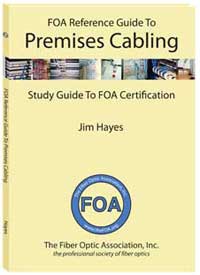



Libro
de Diseño para Redes de Fibra Óptica en
Español - FOA
Design Book Available In Spanish Online

FOA has translated the FOA Guide To Fiber
Optic Network Design book and made it available online to
those studying for the CFOS/D Certification but whose native
language is Spanish. You
can access the Spanish translation of the Design book here.
A printed version will be available in the near future.
Lennie
& Uncle Ted Guides - Perfect For Getting Started
Lennie
and Uncle
Ted's Guides have moved to the FOA website.
Lennie is the place where many if not most fiber techs
begin their education. FOA has just updated the two
guides to ensure they stay relevant - more than 20 years
after they were first written.
Lennie goes all the way back to 1993 when he was created
as the mascot of the original "Fiber U" conference - the
same Fiber U that is now the FOA's web-based training
site. Lennie
Lightwave's Guide To Fiber Optics was created
as a beginner's introduction to fiber optics. Over
60,000 printed version of Lennie's Guide were given away
and it became one of the first commercial web pages in
1994. Uncle Ted's
Guide To Communications Cabling was written a
few years later to introduce techs to "Cat 5" - UTP
wiring - that had only recently been standardized in
TIA-568.
Lennie and Ted's Guides are used in the current Fiber U
online self-study programs and are still the best place
to start learning about fiber optics.
Lennie
and Uncle
Ted's Guides are online at the links here, can be
downloaded as printable PDFs and are now also available
as free iBooks on iTunes.

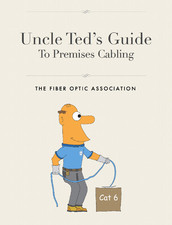
Lennie
Lightwave's Guide to Fiber Optics and
Uncle
Ted's Guide To Communications Cabling
are now available free to iPad users who can download them from
the Apple iTunes store. Of course they are still available
online or for download.
You can also find these free guides on the FOA website - go here
for all the links: Lennie
Lightwave's Guide to Fiber Optics and Uncle
Ted's Guide To Communications Cabling
Download PDFs of Lennie
or Uncle Ted.
RETURN
TO INDEX
FOA
iPad Apps
FOA
LossCalc
 FOA
LossCalc estimates the optical loss of a fiber optic link. This
will save time for the installer of a fiber optic link needing
to know whether test results are reasonable and/or make a
"pass/fail" determination. It can also help the designer of a
link to determine if communications equipment will operate over
this link. FOA
LossCalc estimates the optical loss of a fiber optic link. This
will save time for the installer of a fiber optic link needing
to know whether test results are reasonable and/or make a
"pass/fail" determination. It can also help the designer of a
link to determine if communications equipment will operate over
this link.
By choosing the type of link (singlemode or multimode) and
specifying the length of the fiber and numbers of connections
and splices, it will calculate the end to end loss of the link.
The app has default specifications for singlemode and multimode
links or the user may create custom setups with specifications
appropriate for any application. http://itunes.apple.com/us/app/foa-losscalc/id476262894?mt=8&ls=1
RETURN
TO INDEX

The
FOA has many videos on  ,
including two Lecture Series (Fiber Optics and Premises
Cabling), Hands-On lectures on both and some other informational
and instructional videos. For all the videos, go
to the FOA Channel "thefoainc" or use the direct links
below. ,
including two Lecture Series (Fiber Optics and Premises
Cabling), Hands-On lectures on both and some other informational
and instructional videos. For all the videos, go
to the FOA Channel "thefoainc" or use the direct links
below.
View
a complete list of FOA Videos with links to each video on
YouTube.
Where Are
The Jobs In Fiber Optics? FOA talks about all the
applications for fiber optics, what jobs involve and the
qualifications for the workers in the field.
Fiber
Optics - Live! A
series of videos that use lab demonstrations to show how
optical fiber works.

Cabling
Project Management - what's involved in a
copper/fiber/wireless project -advice for the customer and the
contractor
Hazards
Of Counterfeit Cable
You may
have read the stories we have written about the counterfeit
"Cat 5" cable made from copper-clad aluminum rather than pure
copper. Recently we tried an unscientific burn test on the
cable compared to a known good UL tested cable and posted a
video on YouTube. You can see the results below.

Counterfeit
Cable Real UL-rated cable
The
difference is obvious and the danger is real. Watch the video
on YouTube: Premises
Cabling Lecture 11: Counterfeit Cat 5 Cabling
View a
complete list of FOA Videos with links to each video on
YouTube.
View
all the FOA Channel on YouTube.
RETURN
TO INDEX
FOA
Schools
New
School:
Midwest
Communications Technologies, FOA
Approved School #378.
Find
a listing of all the FOA-Approved schools here.
Find An FOA-Approved Training
Organization
Most
inquiries we get regarding finding a FOA-Approved training
organization want to know two things: what school is closest to
me or what school offers the certifications I need. The FOA has
about 200 training organizations we have approved worldwide so
finding the right one can be difficult! We've been looking at
ways to make it easier, and we think we've got a good solution.
In fact we have two solutions.
First we have added a sortable
table of all the FOA-Approved schools.
You can also use our FOA
Google Map to find FOA-Approved schools.

What
Should A Fiber Optics or Cabling Tech Know and What Skills Do
They Need?
FOA
certifications are based on our KSAs - the Knowledge, Skills and
Abilities that techs need to succeed. Read the FOA KSAs
for fiber and cabling techs.
School News
Feedback
We always
enjoy feedback, especially when it shows how great some FOA
instructors are. These came from students of Tom Rauch, an
instructor at BDI
Datalynk:
"I took your fiber optics certification courses this past March.
I just wanted to let you know that in two weeks I start working
as a fiber optic technician with ___ up in ___. You mentioned on
the first day of the course that there is always one guy in
class who had rubbed his last two nickels together to be there
and, in that instance, I was that guy. Now I'm going to be able
to provide for my family like never before and I owe it to the
certification that I received from you and BDI Datalynk. I just
wanted to thank you again."
"Thanks to our tremendously knowledgeable and patient instructor
Thomas Rauch, who was not only generous in sharing his wealth of
information, but he did so with ease, humor and in a way that
invited curiosity and participation. He was encouraging and
proud of our accomplishments and helped us learn from our
mistakes in a way that did not break our confidence, rather it
pushed us to better results the next go around. The hands on
labs were just AWESOME!" Just thought you should know what a
class act you have representing you in his travels..... but then
again you probably already knew that! : )
In almost 19 years at Verizon and having held numerous
positions, I have gone through many training sessions. I cannot
remember ever having been actually looking forward to coming
back to class quickly after lunch, to get back to the hands on
activities, and walking away with the sense of empowerment that
the information presented was not only relevant but dead on
point accurate! I will be signing up for the Outside Plant class
on March! I can't say enough good things about Tom and his
impact! Feel free to quote me, I can only imagine that he will
open so many doors and change so many lives in the years to
come, with his style of teaching! Great experience, awesome job!"
IBEW
and FOA Partner on Fiber Optic Training
The
International Brotherhood of Electrical Workers (IBEW) and the
National Electrical Contractors Association(NECA) through the
National Joint Apprenticeship and Training Committee
(NJATC) in
a partnership with the FOA has published a new textbook for
training IBEW apprentices and journeymen in fiber optics. The
new textbook uses the material from the FOA Reference Guide To
Fiber Optics with new material and photos from other NJATC
training partners.
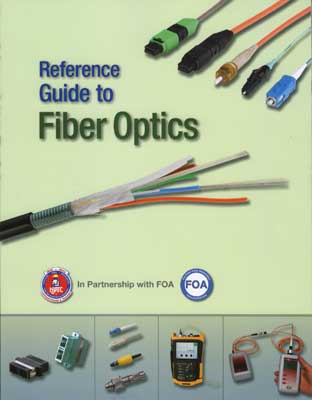
Quote
from one of our certified instructors: I want to thank
you and your organization for all the resources you provide for
the students and the opportunity to offer the certification to
the students. The fact that you published the book yourself to
get the cost down and the unlimited free resources on your
website shows a commitment to the public that is second to none.
I let it be known to the students that the FOA is the best in
the industry at supplying knowledge and resources related to the
communication industry. I look forward to passing on the
information that you provide for the industry.
RETURN
TO INDEX
Good
Question! Tech Questions/Comments Worth Repeating
New:
The FOA Fiber FAQs
Page (FAQ s = frequently asked questions) gathers up
questions readers have asked us and adds tech topics of
general interest.
Real
Questions From FOA Newsletter Readers
Cheating
On Link Length
Q: I have a fiber run for a camera starts at location A to
location B it is 467 feet. Location B jumpers through to
location C which is 2060 ft at location C. Transceivers areSFPs
ONLY GOOD UP TO 1800 ft, but this company only has a multimode
system. Is there something i can do to make this work?
A: It might work as is, since electronics are usually
quoted with conservative specs and will work farther than
specified most of the time. If you have several SFPs, test the
output power to see if it exceeds specs and choose the 2 ones
with highest power. If that still doesn’t work, contact SFP
manufacturers for higher power units.
Pulling Cable
Q: I’m having trouble finding much information on the
matter. What type of swivel should be used to pull fiber and
what would be the correct way to pull armored fiber.
A: Start on the FOA Guide here and go here for
types of swivel pulling eyes. with https://foa.org/tech/ref/OSP_Construction/Underground_Installation.html
and here are sources https://www.comstarsupply.com/cable-pulling/swivels.html
It’s not common to “pull” armored cable since it’s designed for
direct burial, but a kellums
grip on the jacket will generally work.
Errors In A Data Link
Q: What is the significance of bit error, and what is the
acceptable rate for communications and submersible vehicles?
A: On any data link, there is an acceptable amount of
error that can be tolerated. If it’s a digital voice link, a BER
10E-6 (1 error in 1million bits) is acceptable without affecting
voice quality. If it’s a link to your bank, the typical standard
is a million times higher (10E-12). Link protocols usually have
ways to determine BER, like attaching a checksum to the end of a
data packet and having it checked at the receiving end. If a
error is suspected, the packet will be discarded and
retransmitted. Here is a tutorial
on BER and an explanation
of errors in a a fiber optic link.
Math of Fiber Optics
Q: Do you by any chance recommend any books as an
introduction to understand the mathematics of fiber optics?
Fiber optics confuses me, particularly how so much data
can travel over light without interfering with each other,
A: If you are interested in information theory, that’s
really covered by Claude Shannon at Bell Labs 70 years ago.
That’s actually pretty simple. Shannon proved that digital data
was best and how much data could be transmitted with a given
amount of bandwidth (Read
more). There are several levels of math associated with
fiber optics. The real theoretical basis is probably in dozens
of books but I like these:
Top Level: Gerd
Keiser
Middle Level: Jeff
Hecht.
If you are interested in non-math explanations, the FOA website
has that:
Fiber
Optic Datalinks
Bandwidth: https://foa.org/tech/ref/OSP/fiber.html#dispersion
Wavelength-Division
Multiplexing
For testing math (dB loss, metrology, etc.) these links or the FOA
book on Testing
Metrology
and Fiber Optics
The
Math of Insertion Loss Testing - Reference Methods
APC Connectors
Q: Why NOT make the use of APC connectors the new standard
for all adds, moves and changes to any campus, MDU or similar
application using single mode cable?
A: There is absolutely no reason not to use APC
connectors other than the cost is higher and one must be careful
if they are used in a cable plant that also has PCs or UPCs
because they are incompatible. We recommend them all the time
for short links like data centers, passive optical LANs and FTTH
where runs of singlemode fiber are short. In fact they are very
common in these networks today.
GPON
Q What is normal Range for good power in an FTTH fiber?
A: The GPON specification for downstream power from the
OLT is OLT transmitter power should be 0 to +6dBm and link
attenuation in the range of 13 to 28dB, which says receiver
power the ONT must be a maximum of 13 dB less than +6dBm or
-7dBm and a minimum of 28 dB less than 0dBm or -28dBm, so -7 to
-28dBm at the receiver.
Upstream, the similar calculation is ONT transmitter -4 to
+2dBm and the receive power at theOLT is -11 to
-32dBm.
See http://thefoa.org/tech/ref/appln/FTTH-PON.html for the full
specifications for GPON.
Testing
Cable Before Installation
Q:
Does the FOA publish a standard for assessing single-mode
fiber optic cables, prior to use on a specific project?
A: The ANSI/NECA/FOA-301 fiber optic installation
standard covers this in Section 4.1. It recommends visual
inspection and testing if there is any suspicion of damage to
the cable. Many contractors will test a couple of fibers with an
OTDR before installing any cable, just for assurance. It
requires an OTDR with a pigtail launch cable and a mechanical
splice.
Cable Bend Radius
Q:
We are working on project where we need to know difference
between short term and long term bend radius for fiber optic
cable?
A: The bend radius for cables is generally specified
under two conditions - under stress, e. g. when being pulled, it
is a radius 20 times the cable diameter. Relaxed, after
installation, it is a radius 10 times the cable diameter. The
relaxed specification, 10X, is considered a long term
specification. Some of the new high fiber count cables have
different specifications, sometimes 15X or 20X under either
condition. Check with the manufacturer for their specific cable.
OTDR
Resolution
Q: If testing a 40KM link with 1KM launch and
receive cords should I be able to see the connector and cassette
splice on each side? My OTDR setup is at 64KM, 300ns pulse and
10 second test at 1310/1550/1625. It shows as a single event so
far but with the pulse width at 300ns won’t that combine the
events into one event during analysis?
A: You will not be able to resolve a connector and splice
close together, especially on a long link like that. 300ns is
almost 60m pulse width! You will see an even of the splice and
connector combined.
Transmission
Wavelength Compatibility
Q: We are looking at the specs for two devices, A
and B. The spec sheet of Device A lists it is capable of MM in
850nm wavelength. The spec sheet of Device B lists it can do MM
at 1300nm. If I connect these devices via MM patch cord, what is
the impact due to different wavelengths? Will the transmission
suffer significant loss or since both are multimode, wavelength
is irrelevant?
A: Fiber works at either wavelength, but transceivers do
not. The attenuation rate for MM fiber is ~3dB/km at 850nm but
only ~1dB/km at 1300nm. But 850nm receivers use silicon
photodiodes while 1300 nm receivers use InGaAs. The 1300
detectors are not sensitive at 850nm and vice versa. So while
the fiber works fine, the electronics do not. They should only
be used with like devices.
Older
questions are now available here on the FOA Guide.
RETURN
TO INDEX
FOA
"Quickstart Guides"
In our
continuing quest to help people understand how to test fiber
optic cable plants and communications systems, we've created two
more "QuickStart Guides to Fiber Optic Testing." They are
simple, step-by-step guides on how to test fiber optic cable
plants, patchcords or single cables using insertion loss or OTDR
techniques and optical power from transceivers. It's as
straightforward as it can get - what equipment do you need, what
are the procedures for testing, options in implementing the
test, measurement errors and documenting the results.
It can't get much simpler.
Send anybody you know who needs to know about fiber optic
testing here to learn how it's done in a few minutes.
Testing
Fiber Optic Cable Plants And Patchcords
Testing
Fiber Optic Cable Plants With An OTDR
Testing
Optical Power In Communications Systems
RETURN
TO INDEX
-
FOA
Tech Topics -
A
Fiber Optic Tester In Your Pocket? (See the video on
 )
)
Yes!
The camera in your old cell phone is sensitive to infrared light
- lots more than your eye - and can detect light in an optical
fiber or from a transmitter. Chris Hillyer,CFOT/CFOS/I,
Master Instructor, Northern California Sound & Communication
JATC brought this to our attention.

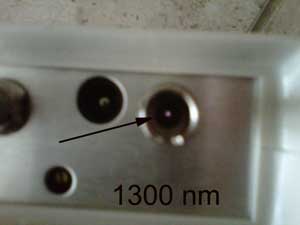
If
you have an old cell phone, try it. Our experience is that older
cell phone cameras have better sensitivity at IR wavelengths
than newer phones, so you may want to toss that old flip phone
into the toolbox.
RETURN
TO INDEX
Product
News
YOKOGAWA OTDR Has Extended range, High Resolution And Multitasking

One OTDR manufacturer you don't hear as much about is YOKOGAWA
(formerly ANDO) which is too bad - they make some of the best
OTDRs, exemplified by this new model AQ7280. Need long range -
how about 50dB. High resolution - 0.6m dead zone. Like touch
screens, but for some functions want hard buttons, it's got
that. Options for VFL, microscope, light source and power meter,
etc. - it has that too.
But the unique aspect of the YOKOGAWA AQ7280 is it offers
multitasking - you can let do a trace with long averages while
you inspect connectors, make power readings, use the VFL or
other functions.
More
info on the YOKOGAWA AQ7280.
FOA
thanks Yokogawa for a gift of an OTDR to use for R&D and
teaching!
Have
you read the FOA
pages on cleaning?
- RETURN
TO INDEX
|


































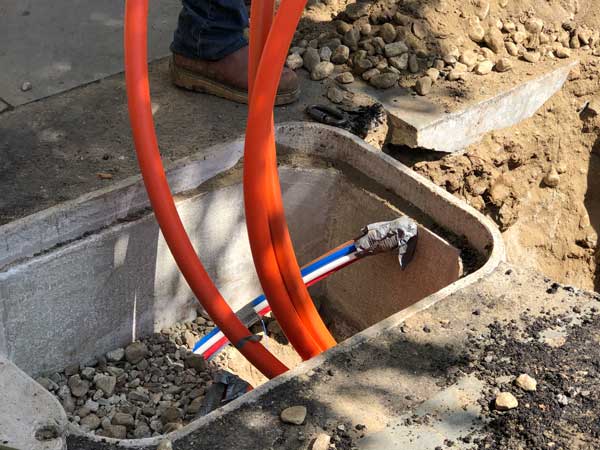








 KYWired
KYWired



 .
.


























